

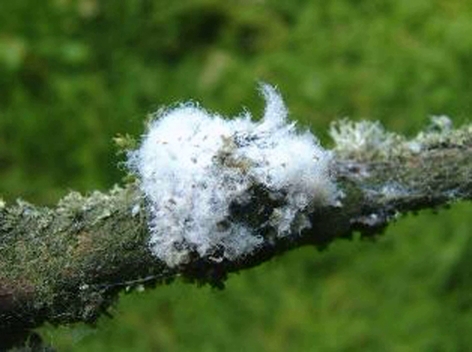 Looking back at the AHDB webinar held in February - Woolly Apple Aphid, a problem which has been around for centuries, has been noticeably problematic for apple growers in recent years, and is the subject of AHDB funded research at NIAB/EMR.
Looking back at the AHDB webinar held in February - Woolly Apple Aphid, a problem which has been around for centuries, has been noticeably problematic for apple growers in recent years, and is the subject of AHDB funded research at NIAB/EMR.
What is Woolly Apple Aphid (WAA)?
Woolly aphid also known as American blight; its Latin name is Eriosoma lanigerum. It affects apples (eating and crab) pyracantha and Cotoneaster horizontalis. The cause; a sap-sucking aphid (insect) active from April to October.
Below: Information from RHS used in a previous EAM Journal in 2016
Between spring and early autumn, infested parts of the trunk and branches are covered with a fluffy white waxy material. This is secreted by the blackish brown aphids. On small trees with light infestations, it is possible to control woolly aphid by scrubbing the aphid colonies with a stiff-bristled brush. This should be done in spring-early summer before an extensive infestation has built up.
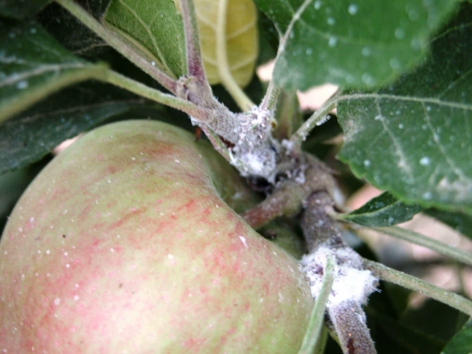 Woolly aphid has a number of natural enemies which help to keep it in check, although they are rarely effective enough to prevent damage occurring. They are eaten by some ladybirds, lacewings and hoverfly larvae, and they are also attacked by a parasitic wasp called Aphelinus mali. The parasitic wasp can sometimes be found in gardens, particularly those where little spraying is done.
Woolly aphid has a number of natural enemies which help to keep it in check, although they are rarely effective enough to prevent damage occurring. They are eaten by some ladybirds, lacewings and hoverfly larvae, and they are also attacked by a parasitic wasp called Aphelinus mali. The parasitic wasp can sometimes be found in gardens, particularly those where little spraying is done.
Woolly aphid overwinters on its host plants as immature nymphs that hide in cracks in the bark or in crevices around old feeding areas. During the winter months the aphids do not produce the waxy material that gives them the characteristic woolly coating in summer. In spring, the aphids become active again, mainly around old pruning cuts or other places on the trunk or larger branches where the bark is thinner. They begin sucking sap from beneath the bark, and start secreting the fluffy 'wool'.
Research at NIAB-EMR into the value of earwigs as predators of aphids is being funded by AHDB (Agricultural & Horticultural Development Board and an extract from the research information is shown below:
"Earwigs are often abundant in orchards. This research will increase our understanding of the biocontrol potential of this predator. The study will assess the extent to which earwigs consume pest species such as aphids. It will enable us to determine if the diet changes over the season and whether any changes are preferences of the predator or simply the result of availability of prey species. The information obtained will enable us to assess the potential usefulness of earwigs in helping to suppress pests".
In 2016 general advice for commercial apple growers, where natural predators fail to keep woolly aphids under control, commercial apple growers use a 'double pronged' attack on Woolly Aphids when the pest builds up (as in this summer) - by spraying with a Magnesium Sulphate spray and following up a day later with Gazelle; the Mag Sulphate spray removes sufficient of the Woolly cover allowing the Gazelle (insecticide) to get at the Woolly aphids.
AHDB webinar February 2021
Cindayniah Godfrey - Resistance and Susceptibility in interactions between apple and woolly aphids
The English Apple Man well remembers the 'spectre' of woolly aphids back in the 1960's when at harvest a bad infection could leave the tree covered in this horrible woolly mess, which when touching your clothes left a nasty brown stain - HORRIBLE!
Below: Badly infected tree in a Tunnel at Brogdale in Global warming Trial. Due to the warmer environment WAA on this Discovery tree has 'exploded' indicating problems for the future if GW influences crops and pests
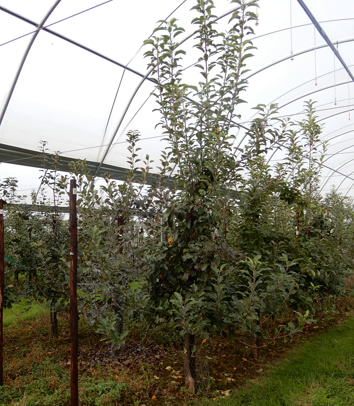 Increase understanding of WAA ecology
Increase understanding of WAA ecology
Fine map known resistance genes
Identify and map novel resistance genes
Background
1. Woolly apple aphid damage
2. Woolly apple aphid life cycle
3. Population genetics
4. Control of woolly apple aphid
5. Resistance breeding
6. Identification of novel resistance genes
7.Acknowledgements
Infestations increase after a warm winter It's a world wide problem, especially in the Southern Hemisphere
Resistance breaking aphids are found in the hotter climates.
Cindayniah said we are still in the early stages of the project, only about 18 months in.
Woolly apple aphid
Protective wax coating secreted form abdominal glands - Widely accepted as arriving from North America, first identified in Britain in 1787 and subsequently spread across the world.
4 defined WAA resistance genes, several more potential resistant genes.
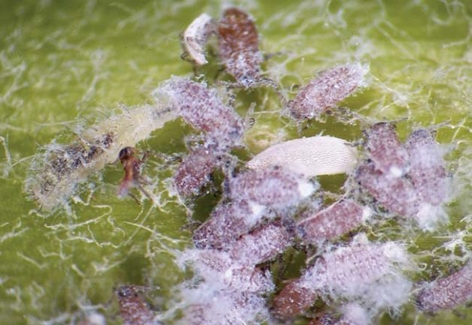 Gall formation
Gall formation
1. Aphids saliva causes phloem cells to divide, forming gall tissue
2. Galls disrupt vascular tissue
3. Galls crack under extreme temperatures allowing fungal infections
4. Above ground: pruning injuries/wounds woolly aphid like to take the route of least resistance, so pruning injuries cracks ib bark etc. ideal for WAA infection.
WAA life cycle - North American WAA alternating with sexual forms on American Elm and Asexual forms on apple. In the rest of the world only feeds on apple with no sexual stage - 'only became a pest when it lost Elm.
The EAM Comments: The entire life cycle is passed on the host tree. Young aphids overwinter in sheltered positions such as in cracks or under loose bark. They are not covered with wool so are inconspicuous at this time. In March or April they become active and start to secrete wool from their wax glands.
Watch this Video from America which explains the basic cycle of WAA: Click on Woolly Apple Aphid
Cindayniah continues: Because the WAA spends it's entire year on the apple, with no respite (no winter host on ELM) further research in identifying genes in WAA with genetic variation shows a difference between aphids at Natinal Fruit Collection to those at EMR for instance, but no real difference between on site aphids.
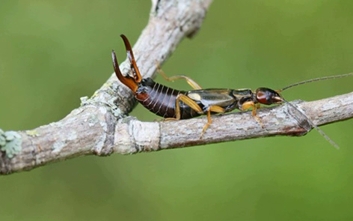 Control measures are limited scion control with Spirotramat (Batavia & Momento) and FLIPPER natural predators like parasitoid wasp aphalinus mali earwigs and other predators. Resistant rootstocks become the only real control for below-ground aphids, because a grower is not going to spray the roots on the 'off chance' WAA is present. So combining rootstock resistance with more traditional methods above ground seems the way forward.
Control measures are limited scion control with Spirotramat (Batavia & Momento) and FLIPPER natural predators like parasitoid wasp aphalinus mali earwigs and other predators. Resistant rootstocks become the only real control for below-ground aphids, because a grower is not going to spray the roots on the 'off chance' WAA is present. So combining rootstock resistance with more traditional methods above ground seems the way forward.
FLiPPER is a bioinsecticide/ acaricide that is active following CONTACT with the pest body. It is active against all stages of insects and mites: juveniles and adults, as well as eggs.
Looking at resistance genes, Cindayniah talked about Er1 a resistant gene first identified from Northern Spy in 1962 (Northern Spy - Moderately precocious and woolly apple aphid resistant rootstock) Er1 Mediated resistance blocks aphids from the phloem. Unsure how other genes mediate resistance!
Gene Mapping
Traditional breeding takes 20-25 years, Marker Assisted Selection for desirable traits, some markers for all 4 identified traits, Improving markers for Er1 is a key goal for moving towards MAS (Marker Assisted Selection) for WAA resistance.
Why do we need new resistance genes?
Resistance breaking aphids have been found in: Australia, New Zealand, USA, South America and Europe!
At least 3 resistance genes have been overcome by aphids.
WAA with resistance breaking genotypes may be able to feed because environmental conditions may influence the expression of resistance genes - spread of resistance-breaking aphids on infected material.
Essentially a few resistance aphids can spread resistance to other aphids as they explore material infected by resistance carrying aphids.
Variable resistance of Malus ssp. and domestic accessions
Looking at Crab Apples with appropriate flowering times
Can act as reservoirs for WAA
Practice is decreasing some areas but still recommended in other arts of the world.
This will allow us to look for novel resistance genes.
Why do we need this?
1. Growth in standard conditions
2. How growth and reproduction vary on different rootstocks: MM106 and Growth MM116
3.Growth in seasonal UK conditions to inform inoculation protocol
Plant and aphid health could vary drastically in different conditions.
The English Apple Man concludes
I have probably overdone the detail in this week's Journal, but the dedicated application of science targeted at solving one of the difficult pests challenging apple grower world wide, deserves recognition!
Below: Cindayniah Godfrey
 I was so impressed with the presentation by Cindayniah Godfrey and below I show her ambitions.
I was so impressed with the presentation by Cindayniah Godfrey and below I show her ambitions.
"My project will identify candidate genes and mechanisms of woolly apply aphid (WAA) resistance in apples, the genetic diversity and life cycle of WAA in the UK, and assess how some clones of WAA are able to overcome resistance genes in apple. Ultimately the project will aim to pyramid resistance genes to give resistance to resistance-breaking WAA.
As part of my project, I would like to survey WAA genetic diversity across different regions of the world. Please click here to read more about my project and how you can help by contributing samples."
That is all for this week, so until next week
Take care
The English Apple Man